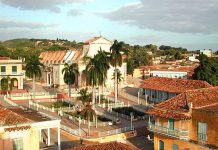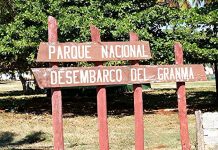
Contents
Origins of the French Tumba
Tumba Francesa literally means French tumba and is a tradition of dances and songs that arrived in Cuba in the 18th century, thanks to the emigration of several French colonists with their slaves when the Haitian Revolution became visible in 1791.
These wealthy gentlemen mostly settled in the eastern region of the island, mainly in what is now Santiago de Cuba and Guantánamo.
These emigrants brought with them the coffee tradition, which meant a certain economic prosperity, but they also transferred their traditions and cultural manifestations to Cuba.
The French ranchers who had settled in that eastern part of Cuba allowed the black slaves to practice their dances and songs, with that unmistakable sound of the drums, when the festivities of the Patron Saints arrived.
In this way their traditions and culture were consolidated and strengthened even though they were no longer in their homeland.
In the French Tomb, Dahomey music, originating from West Africa, and traditional French dances are mixed.
Over the years, the generations that were being born continued to learn this tradition from their ancestors so that it would not be lost over time.
In 1886 slavery was abolished in Cuba and freed blacks were migrating to the towns in search of work and sustenance, thus the Tumba Francesa societies were born in several cities in the east of the island.
Currently in Cuba there are three that are the most recognized: the French Tomb La Caridad de Oriente in Santiago de Cuba, in Guantánamo the French Tomb Pompadour Santa Catalina de Ricci, and in Holguín the French Tomb of Bejuco.
Currently its practitioners are the eighth generation, and they keep their songs, dances and touches as taught by their ancestors.
For preserving the almost exact tradition for almost two centuries and continuing to teach it from generation to generation, in 2003 UNESCO declared the French Tumba as a Masterpiece of the Oral and Intangible Heritage of Humanity.
Santiago de Cuba was declared first and then Guantánamo and Holguín.
Instruments, songs and dances of the French Tumba
The composé, who is the lead singer, begins with a solo which is generally in the Spanish or French dialect. Then when he gives the signal, the wooden cata begins to sound, a characteristic instrument of Cuban folklore.
Then follows the sound of three other drums called graves.
Dances begin to the rhythm of this music, which are performed under the command of the Mayor of Plaza.
In these dances, together with their costumes, the French influence is appreciated and in the instruments and songs it is noted that they come from the Haitian culture.
Apart from the three drums and the catá that start the music, the tambora, which is a small drum, and metallic maracas called “chachás” are also played.
In the French Tomb, the choir and dancers are generally women who wear long dresses in the style of colonial times and African headscarves are placed on their heads.
The performances last around 30 minutes and are a series of songs that sometimes last until late at night.
These festivals, without losing their essence, have adopted features of the sociocultural environment where they took place, and today they are an indispensable element of a distinctly Cuban folklore.
This ballroom dance consists of three parts that are notably different from each other: the Mason, the Yubá or Babul and the Fronte.
At present the two styles of the French Tomb that are most interpreted are: the Mason, which is like a parody of French ballroom dancing, and the yubá, a dance based on drum rhythms.
Society of the Grave in Guantánamo
Pompadour-Santa Catalina de Ricci, is the name given to the society of the French Tomb, which has its headquarters in Guantánamo, the easternmost province of Cuba.
This society has customs and traditions very similar to its other neighbors in Santiago and Holguín, since the origin of the French Tomb is the same and its peculiarities have been transmitted through the generations that have been born.
In the whole area of what is now the Guantánamo province, more than ten societies of the French Tomb were created, but until today the one that lasts in time is the Santa Catalina de Riccis or Pompadour.
Currently this society has its headquarters in a place known as Loma del Chivo, located in the eastern part of the city of Guantanamo, and is considered a relic of the folklore of that province.
In his interpretations, the process of transculturation is reflected since the arrival of Haitians in Cuba.
The Pompadour-Santa Catalina de Ricci French Tomb is one of the most pure to date and its songs are related to events not only in its environment, but also in the historical and cultural events of Cuba and the world.
Their songs can be humor
Society of the French Tumba in Santiago de Cuba
La Caridad de Oriente has its headquarters in the eastern province of Santiago de Cuba and received that name in honor of the Saint Patron of Cuba who is the Virgin of Caridad del Cobre and who has her sanctuary in that city.
This society was founded on February 24, 1862, and was first called the Lafayet French Tomb Society, in honor of General Lafayet.
The music of this society, like the others, is characterized by the playing of its three great drums or tombs.
As an interesting aspect, it stands out that the performers of the toques are named according to their instrument: mamamier for the premier or principal, secondier for the second or bull, and cataye, who plays the catá.
In the case of the cha-cha or marugas they are played by women and are to accompany the choir.
In the case of the tambora or requinto, it is hung around the neck of the person who plays it.
Within the dances, in addition to the yuba and the mason, they also perform the tahona, in which the dancers dance around colored ribbons that they weave and unweave as they dance.
Some of these dances are considered by scholars of the subject as antecedents of the guaguancó and the Cuban rumba.
Several generations of the Venet and Danger in this eastern Cuban city inherited from their ancestors the tradition of dancing and singing in the French way, founded on February 24, 1862, 142 years ago, it was first called Sociedad Tumba Francesa Lafayet, in honor of General Lafayet.
According to some investigations carried out by people from Santiago in the estates of the French Antonio Venet and Santiago Danger, located near the town of El Caney, the French Tomb of what is now Santiago de Cuba had its roots.
The current members of this society dedicate their status as a World Heritage Site to Gaudiosa Venet Danger, dear Yoya, who she asked before she died that the French tomb from Santiago be kept alive.
The French Tumba can be appreciated by those who visit Santiago de Cuba as well as the ruins of the French coffee plantations.
To highlight the value of this Franco-Haitian tradition, the audiovisual producers of Lía Videos in Santiago de Cuba filmed the traditional dances, touches and songs of the French Tomb, and edited them into audiovisual material.
This society holds the Flag of the Hero City, the 2000 National Award for Community Culture, and is also a Masterpiece of the Oral and Intangible Heritage of Humanity, and the 2004 National Living Memory Award.
Tumba Society
The society of the French Tomb of Holguín resides in Sagua de Tánamo and is named Bejuco, it has its emergence in the middle of the 19th century spontaneously.
Its period of greatest activity was in the final decades of the 19th century and the first two decades of the 20th century. Approximately after 1917 a period of less action begins.
His oldest songs are related to the Cuban War of Independence, women and others to enemies, or thanks to a friend.
This society has made some presentations at the carnivals in the municipality of Sagua de Tánamo, where they are based. And they have the support of the National Council of Culture.
Currently the French Tomb in Holguín has suffered a slight decline due to the advanced age of many of its main tumberos, as well as the loss of composé or main soloists who sing in the Creole language.







